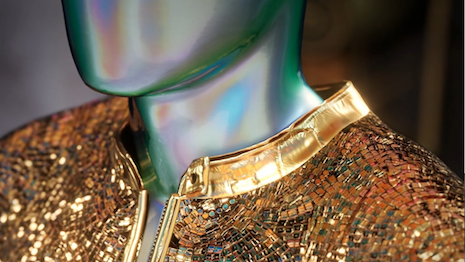By Abhay Gupta
The convergence of luxury and technology has been one of the most fascinating outcomes of the digital revolution. Innovation is the parameter for exclusivity, and what better ally than the shape-shifting panorama of digitalization?
In a post-pandemic world that is driven by artificial intelligence (AI), augmented reality (AR) and virtual reality (VR), most high-end fashion brands have slowly but steadily entered the diverse digital ecosystems such as the metaverse, blockchain, NFTs and social commerce.
Here is a glimpse into the digital transitions of the luxury brands that are helping them remain relevant and reach broader customer communities across the globe.
Social commerce
Social commerce is the process of using social media platforms for bringing the products directly to buyers. The entire experience – from product development, surveys and research, to the final checkout – is carried out on the social media platform.
As the social platforms turn out to be where the crowd is – irrelevant of the status quo or the purchasing power – most high-end fashion houses are taking the plunge to connect with their fandom and facilitate interactions.
Social platforms such as TikTok are holding the spotlight more on consumers rather than the brands, thereby channelizing better customer interactions.
Brands such as Burberry leveraging Facebook Live and posting bite-sized videos for product promotion, or the Pinterest board of Dollar Shave Club dedicated to positive customer feedback and unboxing photos, clearly wave the green flag to social commerce.
Image – Pinterest – Dollar Shave club. @dollarshaveclub
Metaverse
The virtual universe with its own digital currency and market has established its reign over every industry by 2022.
Per Statista, the global metaverse market comes up to $47.48 billion in 2022 and is set to spike to $678.7 billion by 2030. No wonder the world of luxury is swept off its feet too, into this online world.
While luxury brands Gucci and Roblox came up with short-term art installations, allowing their visitors in the meta-world to try on and buy digital products for their avatars, Fortnite provided a space for players to virtually hang out together and also buy digital products.
Gucci also facilitated the Gucci Garden space for visitors to walk around and discover various brand campaigns.
Louis Vuitton launched a virtual game to celebrate two centuries of the brand.
With the metaverse, the luxury fashion brands get to stay true to the sustainability factor, with reduced carbon footprint for every digital product. There is no overstock as 3D renderings of products is tailor made for buyers.
In 2021 alone, $2.14 billion was spent on online purchases in the metaverse. With the onset of 5G, the coming years will witness even higher numbers, and many more luxury brands will enter the metaverse to build seamless digital ecosystems and boost sales.
NFTs
Dolce & Gabbana became the first major fashion house to release an NFT collection in collaboration with UNXD.
The collection, titled Collezione Genesi, consisted of five NFTs and four strictly digital NFTs and sold out for a whopping $6 million.
What is it about the NFT, and how does it influence the luxury market?
Non-fungible tokens (NFTs), or digital tokens, provide the desired transparency and digital security for consumers of luxury products.
In 2020, the global NFT market was worth $250 million and, by 2021, NFT sales came to a shocking $25 billion.
Fashion brand Dolce & Gabbana set records with the sales of their nine-piece NFT collection that hit a massive $5.7 million.
For luxury brands, in particular, this new digital monetary innovation helps reinstate three significant ingredients: authenticity, exclusiveness and customer experience.
By discarding the intermediaries between the receiver and sender of an NFT, the blockchain brings the customer closer to the brand, thereby initiating an exclusive digital experience.
To cite an example is how the LVMH group, together with the Richemont group, developed the Aura Blockchain Consortium – the first international luxury blockchain. The system validates the authenticity of products by tracing the product map from the raw materials to the point of purchase.
According to the European Union Intellectual Property Office, counterfeiting accounted for $464 billion in 2019.
The emergence of blockchain and the authentication of digital products or art helps to put a noose over fake reproductions through NFTs and their unique identification. Digital ownership guarantees authenticity and safeguards possible resale.
Web3
The third-generation Web that works on blockchain, Web3 is all about freedom, democracy and ownership.
For the world of luxury, Web3 has turned out to be an excellent platform to keep customers informed about the brands’ sustainability factors. Consumers can check the authenticity and origin of the NFTs on the blockchain for their favourite brands.
Fashion houses such as Prada, Givenchy and Yves Saint Laurent have joined the bandwagon of Web3 luxury brands with their maiden NFT initiatives.
Web3 also protects intellectual property and eliminates counterfeiting which is of primary significance to the luxury industry.
Yet another way the next-generation Web has revolutionized luxury brands is through cryptocurrencies.
Most fashion houses today feature checkouts with Ethereum, Bitcoin, Bitcoin Cash, USD Coin and DAI for exclusive, limited-edition products.
The social media followers of Yves Saint Laurent Beauté’s on Instagram and Twitter are now able to access their maiden non-fungible tokens.
As Stephan Bezy, CEO of YSL Beauté, remarks, Web3 “promises enhanced experiences, where artistic reinvention and emotions meet in a new way.”
Direct to consumer
The market shift to everything digital has spurred the direct-to-consumer (D2C) model, initiating a more personalized experience for customers.
The luxury D2C ecommerce is connecting the elite brands to an ocean of consumers who enjoy shopping online, thus anchoring their digital presence as well as building brand loyalty.
Most D2C brands enjoy a strong fanbase, high Web traffic and a loyal customer base.
With the D2C model, high-end brands can leverage emerging technologies to ensure a customized experience for the consumers. They can effectively engage their fanbase through personal shopping services, live chat and virtual appointments, as well as AR-driven virtual product testing.
This, in turn, builds brand loyalty and ensures returning customers, helping luxury brands find success with better conversions and customer retention in the online environment.
TAPPING INTO THE diverse spectrums of the virtual world is helping elite brands to unlock novel ways of creative expressions that attract and engage their customers in a futuristic manner.
Leveraging this digital shift will help the luxury brands to reach a wider global audience in ways that not only appeal to them, but also safeguard the marketers’ authentic and exclusive air.
While fashion and luxury remain as enticing as ever, technology is decoding the equations to make them approachable, transparent and inclusive.
The future ushered in by the new virtual kingdom will definitely be that of equal participation where the brands, as well as the customers, contribute to an immersive and engaging experience.
 Abhay Gupta is founder/CEO of Luxury Connect and Luxury Connect Business School
Abhay Gupta is founder/CEO of Luxury Connect and Luxury Connect Business School
Abhay Gupta is founder/CEO of Luxury Connect and advisor at Fiexglobal, Gurgaon, Haryana, India. Reach him at abhay@luxuryconnect.in.
{"ct":"L0fd8VpwdRZNGrzIp\/ZAh5LTcMMaYF7kKhfyCqcfub7WuOmRrz3S+DBTKRay0NvOciLCmVzwcs4GLEvfLX\/V45YY4yPHIfRpcso\/KPood7\/1pbn0IhbL92ggyY+EHAuZ7OYyJuPSv35hIyH9X2N6R+7XUEbHMwgmRlRn28DHYIvyDrNpzyXRMcRFXsogpG2+BEuAYmCwf4NVDnCFKVrLX4w07kdfdM4WtuIo0JoDS8r9gEMKsbMZdYSiKI2KYZg38CPqvW6dool6Sx35oaIm6nPmva03tiwzmYBFcolzyFe3TliRZRQDP\/kTn+RSTmELc7EZWsJwBE1e7icw2Ux\/MjOpbrsnTI6ifLRRX+XhS1\/+7N9IfG7rpA8Ucts6r+tDW\/qP6bmawJdJX1PZxCsLAsw\/Y3\/zo+ZTwvSts+lJyPl19AI3tkYhy3UhaE1BnNkjyRjQCx0L23mEB5N8chdlOo2EUXvBy\/LXUkMM0lF6MhT9wiJojv75eZKofWo25wDleX41vk2f1dxwMlF\/VQ2zEGAbZuX4IBONwUTLGglCBGfo6UlYOtvmiC5fT+Qijj6q7gyEdGv7qObiKpe\/MynjYhEKLf\/EVHkPc3mTqCvDK6Ugg4lfUpQS80t74XjkTAEmce22HSaKAwdsi7lnjCac0ha\/ECedV3HZ2YC5n0Nbj6jgCschuKFf6AD9dBBoYJ9Bzq9vqdcEnAL13V5CoSvbh9KvX18dRldHS4wSoXpB9BbIBoHotNWqCRFM1jTWGDSbCYG2Z0oVvEjD6rsiAt0MQdjO3NBiTlDoCOOcajocoTUeuHtQNfwPxad0s4QdZosIEh6To2nVLtOtX3IkkRc1e0PpwwGWZWHER6aaPazwAjZS5EQA6EZoNRp8bnlCIVNVtPqvhuABNEtjQixigrdSsEu6K0+d8zPDvGCDq02Gd0c6AlsB9GRTv\/7NoC+b0HrH8KiEqBHaz3WQQjkQUHQrYiXC\/3Fmzrps+HL81zhX0k8JyLlzw1yfK5trTyVqFbclRbHdyDK14EUpuledn+DrT5ESSA\/fj1N6Y+g7wT5g5l2\/TlO8bGPJU6hLW6vY1sB7X5CufzqYzrgxtpWN7zrSFDpf4uH51NEPWtYlJE87jcA8KiOnrEWYAdDBvaDhyZBm5z8J3jjWSldePR9mNxGug0FnysZJZGlHLZrlw02LU+tXBOdeWj1sM\/7kdHjcYso4RkMX4sFCSM4JU\/FmHcfLPReruJty1RntWr1qcwkCgb4NF+X+COdY0BptRJkBQblFCL7R56FuMCfOB6TcL1qjs6\/vv\/OLtsosX5rkXKDiLmEwhw9kopEvFQJWF1Ht24cD40Im9y\/jjwkfRfrc6zB6hv6hONHzZYb\/quJsGnUAotEBHrgePpScuM2g1LI61kTP+Mwtg9XTXjUarcMfXnVw\/U8n5IEt1oh9cTSzj8NjLpzV27i21QMXMgK4AOiHlx92c6BPOzJaBsmMD67cVvnFoGRu\/Zo1+2uTV+qvwvy3Imi6iePiUlP7\/26GzVeSjl\/mHyd+Fmj+9Q1Te\/+w2UAFjU3keDnGRWUn3EzO6gIkcYRCNwu+ry7IwsYhzhgKOwdMSPWpLkowM0fvf8p8W2sdPMRRQI0O2r4ZDYU+4GHEtsfsnvpKnzDF6lcev+yXObh02Bqql1JObTXydwytJV4rbY\/hYYGbXRPekox40tza\/WgSrrA5M5qzoH9Ti2bZAE2wMallQf\/mNRz0Dlug1OqyfxrtEmgZpMV01FwYPSpkq+cWvbeB5kdELMXlVbrFkoLhw57tf9ual9CzWwsedSnlskzfCxSCYr92ItNJyw0PMicfD4b4ucSOEpBRmTPwCBk9o+o4XlH12doCcHgt5R5fzdQ0OHcQNnDku\/CWK+gYXcJSyvmVQTyOukZHO+zuoGru+wPyLMjLbfKOiUWUW7vC0FVq7goubr2Xvo3\/bEFa76dfIeV8YWNLNf\/oF+S3mTMotDQn65A51dKiEnEKO1M0dU2DDluN6KB7sfHIiuCYnhZ\/KJbE2xrTbAwRPIoZA7FyEv70FKX81gx8NiWg8oHDKTGz2gXY1345dto7QlQ9RYz08SiSDkFVFvjZ9VpdNwcAq72tjJsQuCgRyLxyLDK67Ldx42Mu0IYXGjO1x6vyKZrT9rIrraKKWItyYUAnAfNzmcRjYgBvNFF5TEp2VTN1q0o4jBN9dLxdYM+WC+9rfNZhdFioVusHiAgekPG0TzgJUZJ4IOsOrP9yh\/S4zS5juvmVkKK8cuIkHWLJlHqCs7JEl91nqxKlaGbwvmKBQTYxvXoH2nF4+R8xNeA+RGUYtVVSHyco4ts2SwkvcCfzmlA2vw6ZQGIHDF2f2U3igiPW+lycpNQ42EAcMtbX5JghNG9Wz8ts\/ammqpZmzMuDsSnJz9bo2L2loxEx0DkQY7gyLOIYAj2sVQonkR0gP12o5zn49wbIsD6eLJQ2XzUkZD\/ZVWPGOcIk68za08aQcKQa5TfPJliR9Hs\/OWJBxmPv5divJAFuHzZCx2vlVeY8Xx3XtRkOBS+Nh04dPmVMu8tFgXPRjztzDC2jXLZLh2RmYwUBeRfp9g\/xOHhpvOvjlF0CBwlOSpR9FR8HmMFgHQJHdG2aJqIu5NM222UrbaGHk+3SWzRHgzZHjFvqTfW+Kao4ZWl2w\/+A3vU0dbXUlU\/3tuUxSp2CrX8ONWh\/NewuOXe+aU4qRaIdV+DzVKul9994T2TKYJlO6pHcBts6DpaOPKNhR\/56yEcfT6OR9gcbqdi+q2YGFIKTYxPfQClmDjp4KJmQaeq9AY15L7774MIAZk7s\/r+nlDjwBANN\/BeqAeGelbyAl1\/XfjKjEsA6meOyd5lcDjn+9zlA9M1EF+GbI5Y+aMg3Z+q8RZe3bI4hb0UTNoMF2dThDy\/nP2QsLd69tWlHEtKXaRu8GcaYw9meNEozgmRBN6kdm+ZneKYegf4j5ZNg8+9yUXKAxg6keP\/dHrtNMfdk70EVytpBwC7HCr9hxtOEOHh1eVBxcbaEQe8AACrptTvb0htqV2ejeqjafC2t7lcL0lncj5F17WrEqvalqx6olbyHOfbyFOARPZdhfARBlRf+XdxD+uMoCaUiD1Ed1aSUPB01azksIP9xWHP+yNCMBP\/RVpgU523N2ZoNe1BgB064j0QjL8E4CdyL6C6MZ9j5hEpHDHbkA8enZsQHDAt+mlEJn7XM7V7s2rvHxs0Sgcis0i3ZpV+enkMYRssZEN7+Zucw6OtgxS7gMGzpjMGsqe+d8siGAJ1qk9013EPk0dA3Onibeq1zaxmCmVPxnjw19EzE6\/4mFN2lIFUud+HJqu4J1tm4CdGo0lOOkNiA\/mNR10MScYFgCvAMcnnMiGrnHhh64aoEU\/lZKrdv2qQre4WDRwsNvZwTtv4r8dF0CKdLSVXfXDtpCjdwMK1tUjXnDa+XLE03nDrQhAQgN6OohIXnZy0yJCnNz41a5HmjbBMqpsZR\/7I5LirhVv5CtfmIvhFUv3QfI2\/pj\/HnXxAA9OWKHlDu3exc+h0LuRtCwIl8Elu1murW0G1g11c0Cmb6kSrc7sJr06YhxWogX9WrDF25okmoO1YW7fyTXoh5bsyHINMj0b9V0tW6wbttx+I19rKR\/uht2LnU8Y6bKXAFh3IlZGID6d3r1x1yip1OnQXa7DbPAruyH15D4eJ672o1msaTHtqdVx6LkhE5lV6\/pXHJa2jMS8LDE8aCuRVIRad71Qp1uOzPFuBU+5jPHHEdf6gqfs5JT5wNICrFSd4c1aty8XA5MJybaqxk12dmbm3IoYVf6CNg9yNJZapOGA2kKQvWFyIWIwdxAnEzi1rQKAD4bK6TOyIF7BIRoOUKMyOxlWoL6\/0syTUwH16SVA3gkrOBPJyJ5J\/j4JMuP+728MdTRxTtVJc99QwfmTd8bQYC4Jjv0loRgSaJ7Rd5ZzdEN9ckCmOl4OdE4ntNKOmKO+Z7Q6dLLWtJg8\/LbeJTJccc2qN27xKY57TYbB1BLGbGS42QrFAqyBHCzqPHQN4OEZ62EFqchTUAV5j93dpgujhuy2qZdg5v1BUv5p8BCW9pLgQL0rbYtAB+zfpnmAw0\/Ao9I6NhH9lF8dstSmtyUgXCEViozBH2Uq3slLUhUtAoDgqSKC\/VJIZvawK8+Q3WjM9KuSpo0Kd2ViIj9LpnacAEa+nbwDNe5vo7\/\/q6Ot+Owjc7B1abzVf3q8e1NwVHHMsSIjoWuKO5KBlS5ChXfZp3JURRa1++Vgyolc42wZo4rbuoph1AYRsSrMENMxqjPB3oycNql2stGx5uxbP2OC83mFI\/ufqPs25FnjBtYBv0ecVHWqa\/uLkvEE0qLsT1e9d3Pt7SpQDZ4B4+5cBuW2v7s2s8PDreqvJShSoNsWjGE3T7CIXkDHa00gAsOAK4WBVe8mxYk2lrU2ofNZx7mGrzWozHQrSGRaIH+Np8lIi8MxlpSyY+1Cxq9GZVSdajQIGdn5hIS8OIC3skB8ALvVsiBeH7SyLiayo9hgW+t1YW7ahTMUD63H65xKIlKkl8jj+Ps0\/0EHSVxD2Wm1D0yH66LU8mS2WLoIAHDEFaYrwIkiOu52nRuLMwxA9V3X52JAyCEgU3FYRsOOoq6uGG54b1cgGBzYPxZGWott94FKlxRdblU24Zz8rIfCCSxEpVHk9b96BtJecF8x1JuBtvGjz+XMYUE1Mta7MV\/wxVqtzkNDzpUniQ7+2T3\/8wDdja8FqC3WaeaRtr50bpuga61TSp3cMkX1UrUH7VxVt5tp+S1UGWYvB7dSfkY43kk\/icOxaC0hpFl4HM9CRYbtAt556o4C2eqbL3h033UrWpjJbBKl1Ex6XTGe3iRLp90xedZFp0IG6vGPohAgIWOZyM8edr3Bp6UBn9jvSlOMjbCl3HWcv4rILVlnO6El3h1oPDhh\/3q88L\/7CBBMsbzJYO0HaYl3tY7PEVmR5qK9StnETZpRQoCJSW5Wwnf\/BjOgeMwAXOVAOHM0pMk01eUVKZJZPN+7sAKEQGAWO1eS1\/5EW9t9N+uhv6+9VhEnsYVMvgfLgwkdW\/JaAsUHx62\/5Ezs5l96LDgWgAmY9SaZ7+Og\/0JvvpRlrWndSdr\/YIHUCtKctvZzxP8a0lBSfOwVNSbMMKoPp9AvOfAf\/NIxUTjmph+YHZb3HVaBY1gedwVCQ0jg19diDdO99eKhRhBqMeUJ7wcAHM3udCbSPh7fnY0zjM7xfmqskekDVVxCwxhYLMwHz\/8OAxHnn50ZBaUXKdHqRtfcXYjVPZT7hSlG5GrpyQ1xCsqau21O3uiBUvc\/p6uk3BpRYRTNV8Q8xRmAW\/aMztjCXvWqlKhesWzY+2i3uFhP5XmDFv82tubb2wv0p0b0\/+eApXMAcf+c1MyBrE5NIwXJ9ZbK9CSrcyd5sleU5oZrsEYASmeravCOqyHsmyxLYGw9kxOj\/rY\/Nnmby4u1dDo9eFzUffA8tSGTHvc+nctCSVVMnjsbXGRikYWdZUbdD2P2k0hQstyTB0kNucbj8FSFJuXAmH5PEwa4mAja7GlSSCUCVU71IdlHg6AUtHO7WTfCMjmNzFA6PWSRoUlC7LBTogfZMkqGuYWq3QuRdoa++Dm7HnInSUszmLvGUfjo0uDldRLJplVDBcYuY31MCLbTe2mwsUmZ4aWGnh\/tMbFI9CPa31yMVCW5XAclqHA58nZrINDjDGK3+AyPfnf64cQ5tXnJGBtYCFQWxAyoJSujbwCTvzYFNeoL83YGXXp4i\/bONBln7PxXY3qMEO14VQurgtoC1MNWKmcUOJ9KhX2VNKGVrhxnkzfsRem+4n9dgA8EqjVysdm3X83xh1SsGBdg00XafSQFCuz5S+I\/WwZ2v0uNOBA6Q3gLcYGMSEPsTFRECp22BZi8biyvyn6+UCmA3qBqOQNWlASdUp6sczx3og2ekfvRu7cJVIzpr6X0aBTNUgzp+kfnGPHlA3cmOz6E9PqAROya0abj1TB9w4aWvqQzxS+zB2UJ32we3rBRVNp6acdt7cEZPMDJn14ivY\/Qn6KKImJzq9QgOemHvZU0xCCeZXOWndFnFPd8PkOv0iajTvmdmkKZLZEfPBPsYdm9RbL8\/aT\/y\/eoRoLRjN97o3OpwhY4kFzH9+h7DdZmO4rzeVNwQ+S5N9ru7Djf6g+kQejqboc9LF3oqRJ7cLxtvBIbrPEfFJRvTkQwOinm12h3RchSeBZW1+DiK4xD0L9RXOFXDVMJnKsYl8UkkaiIjmnb9wsBtKNf5Q9c996SmCOftXRW+e+sOWE6opynNvgXzLutAKo8rqv7TtL\/N5qDr2WbWY8KAVBBRrDbT6DBjhF5WM6iR+NhYxsZ2vvrhCT2wYlWMu463NDgVXWrUSg+98j84SPLkdSBVK9jjt54YxrjNUJHTDsWFSkpBPy4HFaN6cq2RpIJVtDkyUqofsDGOPyOs7jQVqmUBReWlUwZoUPv9egPW2BhfToBqVsPDMbt\/IfZdaE97Y2iASnmi5fBfLmYRCvoMeUqWay3tkjDDn2pUnu00KLlPBRt6OqTIJub2A+IlByODwtKd4x7PKX\/GmkasXW71FvWGgdELlwPldIzBFN9GW+vf3UJG5UzQT5H2U6OdbOkGzDaJ2Mim8OIRX1TX2keQE\/krB2s935E+lGpTgH6NfyzfHY24Gs7lcJL3Be2a1dVOz43lzCfXAHoJ9AxjZ9VUMqQJwk5beGB8sUWfuopAGA0\/Z1EskkV3uDjTe0g\/dc14A+jSL0aexd96vk2InI6Up4yKPs\/eW6AHaeJiZp3AsRCP9IQsC2umtDfMhSEI2ZHMHOri2TK6K6BPMFSZ9ZVhx\/a4ov\/L7fJFIEe2Z5mQWatBRmCBrb3Bd\/xHgbeEnpfAXIh90USv3jyDZPqjd5wxO+DqFE5vCVDb3kaoxqDB0gBBUCAClZSuytqZQFCvheJBl0Ouvy9zHbDclH83l4abO3oONWkZFsJDvfr2ypgGIG2Jwpn0nMxNuPIem13JiMHu\/yrQFsiev5OBy9Rp5sXNJ\/In8W6Rm\/+VQVDrMHFWNgx+BpQQoSk5ysHUauPUtshW6WubzZ3RD2YjlaIFQfjMBx6q\/VanSQ4xeDCWxffyfkRsTJJh9N\/6X47iwB0PulX3RiC1fWA1S666EfZ+UeLsVgjDyU\/UzhYthPXuzvgTkJ8eSj6AavW75y3wd32Ntk0vQdfaSfr9IPqh88Brc74E5\/U+4Q7boSEDypW043AoXLpJjGtSFqSfAPhOoUzTsdYDD1vvIFhb2iZpdlE9Yhk099ImgDFf13kZnXsADyuFPyTn0PyGpoRjU47cNZQ\/H3eQcqABsKFLv69hvLNytFAbiIZvTge1d5Ya4muOyagCdxDAzX3rJp5ywTAfZ4imBGYI1EzZvHwOMsw3tetUjFGowi60IkFR+15FlYXl735GANVLC4oCGIEM7aeIWpHuaTYA9ALo7uS3Q+QOATBSm6kd3L66mr+AFBk221wjkODftkWfr0sShf3kAYI7Xrb5PoJONDSROd4Y9REPPm2\/HZ8o3YYRmt+LA1UeBmVE2DoIET2yN5RG7txikqG2OXZExDsKVtxWjd4+\/FmXER7+ueNmJtoJaf6vP\/M24l8jiOSinYQoHWMr8Sc79ljjKWx5joMW2282sKkascwEi226P3c5mZqmEopVIh6Y54KMUI3o6ugsLn6OpKJVV3s+epSkncH9lZAmTzdPUwhdgffiXyACZz6m+IHdsSuPoDpnOCum6gOc7eXRtn3x8zVxSMdwkUR9d34aLjCIpi9jR\/HWqYHcwjalZpu+0o0kXIFLlTtg6wGHreoFSB17L+ouB5ymA7XK5ZxcG+enkNFOWlTriq7mHGl+EiM3hUeWOECvXomUTKcB3BXQ41iXcthkMl3cGls9ZfxbReRTdcu2oBeQPqCq+B32fbNsRLPWkMqo4Z4jXfIUIvU5GgkoxFc4Ky2FKh8wJjzLjNb+sXmqijc5xSwgEksUNzYmS7BqMUey9s3lt9OLRmg6uyPMQk0Rr3\/WHlO7PFBRbMFen918YydG7Jc3enYV17shEuQ+\/xzuWwM2Ry3sEtLleXldaLs7K4dK3N8X34zPaORmKI4s1WPSoHty997I+WOO3LSS1RpHVtuQla\/uXOs7MTUgJc8smXREjBrtOmfn+6dr2Nrs0eIRsw\/LjdmjOxIXFNJr5n22gw6vkR3ejfghm5b\/+BYlB7s5WxzRpgVbWp2mVh2HQOagjASFZJ9n9ZTOJqvgIWNkarXeduGItxY6VSO90LrgaY+3yjRNLCf6K0QiZ9OHibSGEaJZfJFyQpc+Czf6NqCAOno08bAJrCQ8qu4\/2wgqnv1c5JF5Gu74lVKLs70LO2hzkRLIejSA8TGqquANXCJqT1Ob3lFfF6\/slHwkBGQPxzl0rQau6Lfjp7vLEB9+\/8SCfnmk0suCv4FSfMAICuPcMY8\/p+ZJdLvnEJle1bED1r7PJOCh7eRYTd5dllg68UTmhlgXkiOBfmAwMFXf7XPAv6nIAV4YdNyJxt8uLKAZ94hr19H+l\/LQjkLBsFGWGygG\/xoEMuvOimdQUFLOjS2HbfzNESIXe7kx2ZuzkW0KBTKVGL3gbafI4ki4NrYqgUr+4jhaY2U1lxjn\/NzPA\/8ZSI7bwFoisDoAuT7R9RY5IcHu9ALpDgX++FHtg1\/pkhDrP9vk9Gqr0fop1c6IkJzeaYqDGbU7TQT9fE3+YzB9AeqYHp5G8ZT6mm9YnzQ5NuKqMSaU\/vsc0u+tll0Xl3\/odKkw4037nA1EzYnrQLpdVynQEptwfEP96JWj3XTZSK9RwZapURPkxowolVvLFjWkJCh9tX2uShnCsmPpCzD\/7J8JKzxmLkfKSorFjWDmfsHgEScPWKKEuBN\/45WzMPFiqeqA0C7RRmPjF9MwxfbqCSB8TWK86rQom\/gF7loyoOZnt69voRbJCu7SeSbdmCW+xeugSVlEy2PiKb0uMH7fVK6Za+1KUeUAwslQzjI+da\/jx3AMUIpb1LUp6xJiz0sgJDnBfXQqGv+z31staDVsnncGSyymzjMaeVZpOx5lMY8nQCY0Ug7b6Yl8Uggobvub75UIY3xk4z5lvXu8BE6strxM3N3MwBrB3nXzi00BMo34NCAPyLB9SUWNR0PI0e91WyB1mGlT2IvGRJe9n+y4neR1PHCcKn6J0nc8WBiltMyGF8NEbJznI6n93BGAtpON\/K5r7b+YxmpwaAEHkQy7\/fcj92QyFrc1uwUUTiyi\/kky8DAdKQM9DGI4j+9cFbqsfZdkkOwfs8fFKecy1xiAah6UOyEmDZ\/KSM48zWGvkiMO4c8SJNmMWLPj3uGr7xJSEp6u5kSEYE8z12ct29ASMMgx9ckwGLb+Hua6toLOk5cOot6lYtcZyk52EcXTuSYEIE86UqTjIxwYfvkE1O1VfgaWjOxaoVdXB4XsJ3EQepNGuouNFTkMZZpjSx+5op8OrYp3efoqCtyGGYR5LJH3cu\/TrF3nwkkbEMSaa2yhvBATvYRv3KFwUUcUbypbkbpGnod9eebEKr89jl2Re5NOxb1pQa7ge3W+G1EIL8XuQA2aHf5O7HZAij0nxGOnOvKGPB30zX2sGPFr1xX7zhcBdQ2inVM6yTfXzaqH7i1KP5krlcKh7LTgGFoenC2ZS4FqKv3xRXy+ypWa3G+DlyF3QO6kCQ774cpF\/ZFUM2ktW0KovirVq9\/HjFv09f93Aaeyc6Ed5wezSgFlRUTXD4BPnNARWT0wochVUqjSP3eUacJM1RasxziF5f4zG7MNa62IMcrmz+aftG4OJLJhDovHGlKQ\/6LbdOCZVh8pyYrKSx8WXnl6jzwmuZtP1pt2tekBz5lRxPKU94UW5a8lNmjxDOtJfRK1E4oWrahHQbiD25yLxc0T\/77TIcEBJnIMAcC6TOsbg7iG1Hhsq57sbcNd0TT3NddHk\/KGCLy\/yfCtBZP9vV0DQtAZPg+rp4vb27bWfgKlF+0TGOWHzqfijnE0s2rN8h7EUDh73iB9cgN8ew9\/+POIOauS8funzoOs4GsuHWGsTCYxaShC6luWW1Sf039085kc99CElzfmJDiIAZbf5wW5a7BvZiyO38krTU1hPKrUQqX9gpOSWFiYWkWU1lttUX6+mtP7nq0fHf7DH83bs8SRUndOQsnXJVZ85wFM2BZt1G2RNmhFuUXfBBh0nfDcmU0DjhpLJ+rx3jVfrSWaE5ea9y3g\/cBZKwmRWcLRvGNiF4feFWxoXM+6Jzs03jH289qkdh1kKWD9eX8pW\/h4lft\/oRt5wRgd1vWZ6prdxRKHnCYwGzqAn4dgt\/CTGLjqJF3m0Ls47sI4r0z9w3sWwIwX6WrrJGEEWuFEtOUXJ64G07gilOwKWuZcFou7cIB3CQPNG\/6RZi8kR19lrIUDAXuHcqvL\/rN1yn68SWMlkuYoVWfOUXKRsomM5Z\/qxObEn40lA6mD9D1Lq+pD9XH7rhNEUTll1EHDiLpzBDt24YZqkaLEqy4JMbIhpUenIm\/m3PCF4KeLa1cXqK4DkXA2Qe2nLB46yKGWIXUqBksPsF1frJVgQ3EmbJNW3rFB8q0cLQT7S\/NHrzQZHUDduiw\/Iwn0\/YahMD6RY2ZstNPv\/gonAy8\/SMwwhjq8NG59jdUUnwuvxwjRQQ0M+\/OOE4x0R+645FLcUxPEbhPAQHAytrO6Rk9drpf1MTJNW9HmeY4OIDSg287yNhd2xgireyzlJWMXP4\/BAfQ4OBb9zHtko4CIUVdTgHWES6hD4INB9L\/3APxc6G7qMcIc8FKgeYXET+JlXj\/9Rn76cHq4AGC0QpYOD0BCWEiq8js4svTJL4edQIUjluMONUiGcLSC4EZSR\/ceTBot6hBU6zHivpOJ9OK9Lvh5z1FrXK56\/mshgt\/QSxE+kzlhOlPkFaEhYLirysoVTNgGx40BxnUaQPbZShRmdCAqcuKfQWXV9XkzPCfyNRsQymG8Mf1PpKdme6bpra8G0uB+lt02Ew5NepsLhM\/b2Y6LbTIjIGu46N2IXTfmsCPJL\/pi1u01OzBBuB+fVLyvPB9hy2CZDDtkIcPut9NQG\/XF9dzvPC9sMV9wSGH9AYiMrIEja9mEkAfN9\/9LyOLi+hE\/zI4GybwSqvQU7gWiV8isiL\/EHBgmEy22pQo96DL6uOQ5en6IhwI6avQuJObbgqqxESb8Ye3+y0Stn65sQxHcux2J5+3\/btMmFEwj4uwvWbRSFsxc4Xe2DrBK9LEQPWIDDdZB+mkT3PTQavEI486DBdjT50VY\/BBy3\/rfUUjEMgk\/g8zS1mrJBx9MmcG77v4t1zAsxQHV1\/xtC059Q9LQLUp3p7fpNXEJp2hH26UbfhJ6gjuQdRA3\/2rOAsAy2wZtiZRA400DE3MMsVFqDWpbvCqiiiIYgpKlIzIIqJqEZ+JETlRy1SOF1UZeDtajjuir7b5CTkvz6sAlS16D7llVEIM1CGl\/fW4zx6qUpH7C\/fWjLb5SJoJzasCMVmaNL0QU2X8yT4fkOMVPz9QiaAOuDlz0ONZc1ochb51BX6\/MR71z8ZHx6eJnLsRD3g8\/MpZh7scmb3T9mZjYT+wvg6Oiui2hhiAqZgJyefOXnx8HA0lzgdRRqdsxgB1pTUDQENdWUgilVcZ4Mod8r5L722\/o3v4lVLWVL00mFHjp2Vdb8C3V5Q0gYc0UHL9JEa5W+\/aO9k6nwlg\/TI2pj7bT0\/Qf70UBwwSyJgzPNloXpBT7MG9709DlCpyPYpgstTnpjhinnp+5Wm+kewOnIUfYrG6mG5Be5t7ZnuHLWCgm514GDHYWZOqL65YEe5Hx7KO39mJRFGT4e8B29NsxIF80N1veVJoLoMWFcNFK6Fpw7pyDRVEOdyhFutbEZvDVxU5BTwkNPJ5ASJbh7QLqEphqD0FT1zlP8x30LMP5NRGC3VInioumoRRxwCkYMRKlTB2cYkY5OmqO46K+RYGj9yp0+sZQNU\/K\/38MKzLn065teFQbJUluuD7\/7KIzkeathVHscwzDQCb\/b6cncfm6kSY4fi3zbAcUgvM7NV7ZcgdjwQt\/8LkXL\/GkRCO2lXin9oEMcWIYYkhh1+L5BVQvK8fBx7DIu6C3tpo\/445w8cPf6fxVQeBwWpDo6ni5qwL5N6yeJCECG19Pvw6el9Fd1xpaRVarWN1jvMIJIEBm9qNyYNNsyk7P4uEPsH4EVz+ZS2mLRnULV4SkSmf2AOPfIgN9pOkIMKW8fZ\/WkQrNUcmJJihcpA0sIJiLOwTwnGJh0KXlqHQxhmegVygZjce5TZy93e\/S+cz8E7OBplKfgD6wLngTN40peAM9fNkzV+aV8NR+wDBEWOQnqpVTz2RKDdVC1jv4Z\/akO+lTUkdbChyrO5ZDkCFbvsntbjKQ\/LRhU7aaDjuajzC3Vjy74IfembaADmyYFcVa\/2BmX+0irTPLzRiDqtw78VZy0Fo3YvuMZFKh8xLy+XrupE94AplmsG5A3\/J6ShIKTri5dY+MilFS+6tBZNTV4zHAA5\/Sjc5SSvGeKE9g8xPvoNIzhsa+RV5qBGHikVo0bFbW7zHhLfgC43EV0KuAmt9\/tjA9ka0+8MQCrt7UnUy6TRkgdoQ3q+r1qeJupXYfblqsBmgnYCLEzdThEZKgjxzFxde4bf+ZMUBQx5wVy925u\/0nsLz\/eTqZTbobjcFyAPCmv6Z\/h\/+MTZVA=","iv":"78036799637c3173ecb2b1a93b917b11","s":"eb5a656dbc94db18"}

 Dolce & Gabbana’s NFT-enabled 2021 Alta Moda show raked in $6 million in sales. Image credit: Dolce & Gabbana
Dolce & Gabbana’s NFT-enabled 2021 Alta Moda show raked in $6 million in sales. Image credit: Dolce & Gabbana  Abhay Gupta is founder/CEO of Luxury Connect and Luxury Connect Business School
Abhay Gupta is founder/CEO of Luxury Connect and Luxury Connect Business School